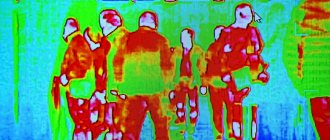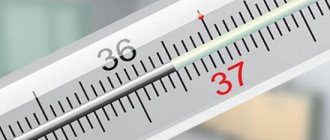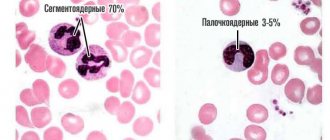Author:
Amelicheva Alena Aleksandrovna medical editor
High body temperature (fever) is a common symptom of many diseases, a temporary increase in temperature, a protective reaction of the body, most often associated with infection and inflammation.
Body temperature can normally change during the day - be lower in the morning and higher in the afternoon and evening, varying between 36.1–37.2 ℃.
Fever in adults may be accompanied by the following symptoms: chills, increased sweating, headache, sore throat or ears, muscle and joint pain, swelling, local redness of the skin and joint pain, cough, difficulty breathing, loss of appetite, general malaise, weakness, fatigue, dehydration, irritability, abdominal pain, nausea and vomiting, diarrhea, trouble or painful urination, blood in urine or stool.
Fever in children may be accompanied by the following symptoms: persistent vomiting or diarrhea, abdominal pain, unusually colored discharge from the nose or eyes, headache, sore throat or ear pain, cough, difficulty breathing, skin rashes, continuous crying (in infants), loss of appetite, pale skin, dehydration (lack of tears when crying in babies, infrequent urination, dry skin and mucous membranes), febrile seizures (in children aged 6 months to 5 years), swelling, local redness of the skin and joint pain, stiffness (stiffness) of the neck muscles, difficulty or pain in urination, blood in the urine or stool, weakness, apathy, lack of response to external stimuli.
The most accurate temperature measurements are provided by oral and rectal thermometers (recommended for measuring temperature in infants). You can also measure temperature in the armpit. An elevated temperature in an adult is considered to be a temperature in the range of 37.2–37.5 ℃ (depending on the time of day), in a child - 37.2 ℃ (measured in the armpit), 37.5 ℃ (orally), 38 ℃ (rectal). ).
general characteristics
Temperature readings vary in absolutely healthy people throughout the day; in the morning the values are a couple of tenths of a degree lower than in the evening.
An increase in values of more than 37° C when measured in the armpit indicates a pathology of thermoregulation. Body temperature often increases gradually. First, prodromal symptoms appear - headache, body aches, general malaise, and later - a subjective feeling of cold, muscle tremors. As the readings increase above 38° C, the chill is replaced by a strong feeling of heat, the skin is hot to the touch, and there is a bright red blush on the cheeks. The general condition of the patients worsens, they refuse to eat. Lips become dry and cracked, and severe dry mouth is a concern. The period of persistently elevated temperature lasts from several days to a month or more, depending on the cause of the fever. Normalization of thermoregulation processes can be abrupt - with severe weakness, profuse sweats and hypotension - or gradual, when the general condition remains satisfactory. The child’s temperature rises faster, up to 39-40° C in a few hours.
Fever is always combined with other symptoms that correspond to the underlying pathology. Most often observed are abdominal pain and dyspeptic disorders, signs of ARVI. If a temperature of 37° C or higher in an adult persists for more than 2 days, you should consult a doctor. If a child has a fever, medical attention is required already on the first day of elevated temperature, since in childhood the mechanisms of thermoregulation are not developed, the fever is more severe.
What devices measure temperature indicators?
There is a wide variety of instruments in the world for measuring human body temperature. Thermometers still remain one of the most popular products, so global manufacturers offer a variety of models. The most famous type of thermometers in Russia are mercury thermometers. This thermometer is characterized by high accuracy, availability and is still in great demand. However, there are not as many such thermometers in the world as before, because they are quite fragile and pose a danger. The mercury they contain is poisonous. Its high degree of deodorization is dangerous and can cause harm to humans and animals.
Electronic thermometers have become more popular in the world. Their most interesting feature was the ability to measure indicators in just 30 seconds. As soon as the measurements are completed, the device will notify you with a sound signal. Alas, such devices do not provide accurate values. Therefore, manufacturers of such thermometers indicate the error in the instructions. Nevertheless, they are the ones who have gained the greatest popularity all over the world.
The most modern type of thermometers in the world are infrared. With their help, you can measure the indicator contactlessly, getting results in just 5 seconds. The error of this type of thermometer is very low and is no more than 0.5°C. A characteristic feature of the infrared thermometer is its limited use. It can only read data from a certain area, for example, the temple, forehead or ear. Moreover, the coverage is purely single, so if the device is designed to measure across the forehead, then it will be impossible to measure in another zone.
Nowadays thermal strips are becoming widespread around the world. They are widely used due to their ease of use. This strip can be applied to the forehead and in a minute it will show the result. The definition occurs along the boundaries, which helps to find out the most necessary information. Because of this, thermal strips cannot replace a full-fledged thermometer.
Classification
According to the etiological factor, fever can be infectious - caused by bacteria, viruses and fungi, or non-infectious - with damage to internal organs, tumors, allergic reactions. Based on duration, high body temperature is classified into ephemeral (up to 3 days), acute (from 3 days to 2 weeks), subacute (2-6 weeks) and chronic (lasting over 1.5 months). In clinical practice, the classification of fever is more often used, taking into account the level of pathologically elevated temperature, according to which there is:
- Low-grade body temperature
. Temperature values are in the range of 37-38 degrees, accompanied by weakness, fatigue, and decreased ability to work. Often occurs in chronic, sluggish inflammatory processes in the body - some infections with a latent period, endocrine diseases. - Febrile body temperature
. Numerical indicators from 38° to 39° C. Its appearance indicates an active inflammatory process that triggers internal causes of fever: mechanisms of the immune system, massive production of endogenous pyrogens. It is observed in many infectious and somatic pathologies. - High (pyretic) body temperature
. Severe disturbance of thermoregulation with fever of 39-41° C. There is a sharp deterioration in condition, severe dehydration, attacks of nausea and vomiting. It is a pediatric emergency because children sometimes develop seizures. - Hyperpyretic body temperature
. An extremely serious condition when the temperature exceeds 41 degrees. Indicates a complete breakdown of the mechanisms of central thermoregulation. In addition to the usual symptoms of fever, disturbances of consciousness with delusions and hallucinations occur. The condition requires emergency assistance.
Doctors assess fever by how it fluctuates throughout the day—called a temperature curve. A constant temperature is characterized by fluctuations within 1 degree; with a weakening fever, the indicators change by 1-2 ° C, but do not reach normal temperature. With the hectic form, which is caused by purulent and septic processes, temperature fluctuations are 3-5 ° C during the day. More rare types of temperature curve include intermittent, recurrent and wavy.
What are the different forms of fever?
The familiar pink (red) fever is not always a dangerous signal. She announces herself by redness of the skin, a characteristic blush on the cheeks. With red fever, the body is able to function quite normally and provide proper heat transfer.
The most serious danger is caused by white fever, which is recorded relatively rarely. It may be caused by vasospasm. With white fever, processes associated with thermoregulation fail. The skin becomes white, the hands become cold, and the thermometer shows a high temperature level. White fever is very dangerous because the heat can damage internal organs.
Causes of elevated body temperature
Causes of low-grade body temperature
An increase in temperature of more than 37 degrees on the skin or more than 37.8 ° C when determining indicators in the rectum is observed with insignificant production of cytokines and pyrogens that affect the thermoregulation center in the hypothalamus. The condition is accompanied by general malaise, but performance is often preserved. Low-grade body temperature is caused by reasons such as:
- Emotional reactions
: prolonged stress, neuroses and neurosis-like states, hysteria. - Hormonal changes in women
: first trimester of pregnancy, menopause. - Respiratory diseases
: colds, ARVI, simple bronchitis and interstitial pneumonia. - Focal inflammation
: chronic tonsillitis, sinusitis. - Chronic bacterial infections
: tuberculosis, brucellosis, Lyme disease. - Viral processes
: acute hepatitis, herpes simplex and herpes zoster, cytomegalovirus. - Childhood infections
: measles, rubella. - The temperature “tail” of infectious diseases
. - Helminthiasis
: giardiasis, amoebiasis, opisthorchiasis. - Intestinal pathologies
: ulcerative colitis, Crohn's disease, Whipple's disease. - Autoimmune processes
: systemic lupus erythematosus, scleroderma and dermatomyositis, rheumatoid arthritis. - Endocrine pathology
: initial stage of thyrotoxicosis, Addison's disease. - Tumors
: lymphogranulomatosis, acute and chronic leukemia. - HIV infection
. - Iatrogenic factors
: postoperative period, reaction to blood transfusion or vaccination. - Complications of pharmacotherapy
: taking antibiotics, psychotropic drugs, atropine. - Rare causes
: chronic sepsis, allergic reactions.
Causes of febrile body temperature
If the body temperature is constantly elevated to 38 degrees or more, this indicates an acute course of the disease. Patients report severe headaches and muscle pain, weakness, and drowsiness. At the same time, appetite is reduced, and the feeling of thirst increases due to massive losses of water through sweat and breathing. Common causes of febrile fever:
- Acute respiratory pathologies
: influenza, adenovirus and rhinovirus infections, ARVI. - Infectious diseases
: typhoid and typhus, malaria, meningococcal meningitis. - Intestinal infections
: salmonellosis, dysentery, escherichiosis, etc. - ENT diseases
: sinusitis (sinusitis, sinusitis), tonsillitis, otitis media. - Damage to the lower respiratory tract
: purulent bronchitis and bronchiolitis, exudative pleurisy, focal and lobar pneumonia. - Purulent foci
: external (boils, carbuncles, suppuration of wounds) and internal (abscesses of the liver, intestines, pleural empyema). - “Acute abdomen” syndrome:
appendicitis, cholecystitis, mesadenitis. - Heart diseases:
bacterial endocarditis, acute rheumatic fever, Liebman-Sachs endocarditis. - Damage to bones and joints
: hematogenous and traumatic osteomyelitis, septic arthritis, sarcomas. - Pathology of the genitourinary system
: acute pyelonephritis, apostematous nephritis, renal colic. - Overheating of the body
: heat and sunstroke, anhidrosis, wearing clothes that are not appropriate for the weather. - Fever of unknown origin
. - Rare causes
: prion infections (Creutzfeldt-Jakob disease, kuru, fatal familial insomnia), vascular collagenosis.
Diagnostics
A general practitioner examines patients with elevated temperatures. The scope of diagnostic measures depends on the clinical picture and the presence of additional symptoms; if there are clear signs of damage to a certain system, its targeted diagnosis is carried out. In case of prolonged fever of unknown cause, the examination is performed according to a standard algorithm, which includes advanced laboratory methods and instrumental imaging. The most informative studies:
- Blood analysis
. In the general analysis, attention is paid to signs of the inflammatory process (leukocytosis, increased ESR). The levels of acute phase proteins and antinuclear antibodies are measured to exclude autoimmune processes. During the period of acute inflammation, the procalcitonin test is informative. To assess cardiac function, an antistreptolysin and troponin test is performed. - Hemoculture
. Blood sampling is carried out during the period of the highest temperature, at least 3 times. The material is inoculated on selective nutrient media; if a large number of bacterial colonies are present, septicemia is diagnosed. Additionally, blood is examined using ELISA, RIF - express methods for detecting antibodies and antigens of pathogens. - Bacteriological studies
. In addition to blood, stool and urine samples and sputum are used to isolate pathogens. If neurological symptoms are detected at elevated temperatures, cerebrospinal fluid is taken. After identifying colonies of pathogenic microorganisms, a sensitivity test to antibacterial drugs is performed. - Radiography
. If elevated temperature persists for a long time, chest radiographs are taken in two projections, in which areas of darkening, cavities with a horizontal fluid level, and deformation of the bronchial tree can be detected. Plain radiography of the abdominal cavity helps to exclude abscesses, large inflammatory conglomerates and perforations of a hollow organ. - Ultrasonography
. To clarify the cause of febrile fever, echocardiography is performed, during which signs of infective endocarditis, valve vegetation, and pathology of large arteries are determined. To exclude endocrine disorders, an ultrasound scan of the thyroid gland, parathyroid glands, and adrenal glands is performed. - Highly specific imaging techniques
. If the cause of the elevated temperature cannot be determined by standard methods, scintigraphy of the whole body with gallium is indicated, which makes it possible to identify chronic abscesses and space-occupying neoplasms. Osteomyelitis is confirmed by bone scintigraphy with technetium. If meningitis is suspected, a CT or MRI of the brain is recommended.
If your body temperature is high, drinking plenty of fluids is recommended.
Treatment
Help before diagnosis
With elevated low-grade fever that lasts less than 2 days, specific treatment is not required. A long duration of symptoms indicates the presence of a pathological process, which is an indication for seeking medical help. Until the cause of the fever is determined, the patient should be given plenty of warm fluids. Physical cooling methods are used - rubbing, cold compresses. It is recommended for adults to drink antipyretics to bring down the temperature when the thermometer readings are more than 38.5 ° C; children are given antipyretics when the temperature is above 38 degrees.
Conservative therapy
Medical tactics depend on the cause of symptoms and the general condition of the patient. In case of high fever, temperature measurements in the hospital are carried out every 2-3 hours to assess the dynamics. In children, impaired thermoregulation is sometimes accompanied by convulsions, so when an elevated febrile temperature is detected, they are immediately given antipyretic medications. A prerequisite is adequate etiotropic and pathogenetic therapy, against the background of which thermometry indicators are normalized. For therapeutic purposes use:
- Antibiotics
. Medicines are selected empirically, the treatment regimen is adjusted after receiving the culture results. For massive purulent processes, combinations of 2 or 3 drugs are recommended, which are administered parenterally in high therapeutic doses. - Antiviral agents
. For influenza, specific medications are indicated to block the multiplication of the virus and speed up recovery. For the treatment of viral hepatitis, medications have been developed that reduce the viral load and alleviate the general condition. - Anti-inflammatory drugs
. Nonsteroidal drugs block the synthesis of prostaglandins and cytokines acting on the thermoregulatory center and reduce the activity of the inflammatory process. NSAIDs are used that have powerful antipyretic properties. - Glucocorticoids
. Prescribed for severe systemic autoimmune or allergic reactions that do not respond to other therapy. They are used with caution for infections, since adrenal hormones suppress the activity of the immune system. - Infusion solutions
. If the temperature is above 38° C and the patient’s condition is serious, rehydration and detoxification therapy are required. Saline solutions containing essential electrolytes are poured in. Treatment is supplemented with diuretics. - Vitamins
. In case of sluggish processes, ascorbic acid and B vitamins are used to stimulate the immune system. Metabolic drugs that improve metabolic processes in cells and have a tonic effect are effective. The products are combined with antioxidants.
Surgery
If large abscesses or foci of osteomyelitis are detected, they must be drained and the resulting cavities must be washed with antiseptic solutions. For diseases manifested by an “acute abdomen,” abdominal surgery with wide access is indicated to remove altered areas of the intestine, followed by sanitation of the abdominal cavity. For malignant tumors, radical surgical interventions are performed (removal of the tumor along with the surrounding tissue and regional lymph nodes), combined with radiation and chemotherapy.
How to lower the temperature correctly and in what cases should it be done?
You need to start lowering the temperature if it is above 38-38.5°C, lasts more than 3-5 days, or the thermometer is approaching 40°C. You can do this in the following ways:
- the patient should drink plenty of warm, unsweetened liquid;
- Cold compresses placed on the forehead, neck, wrist, armpits and groin areas help well, as well as cool foot baths and wrapping in a wet sheet;
- Rubbing should be done like this: moisten a towel in warm water, first wipe your face, and then your arms, body and legs;
- A cooling bath will help lower your temperature and wash away toxins. First, the patient is placed in a warm bath, then cold water is gradually added to it to a temperature of 30 ° C;
- Only a doctor can prescribe antibiotics. Before his arrival, you need to take antipyretic medications.









